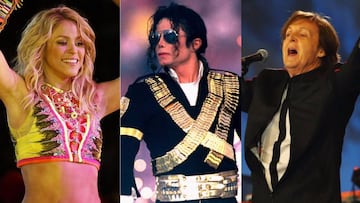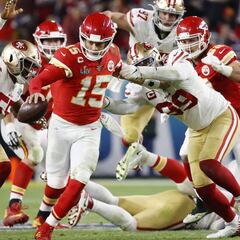Every halftime performer in Super Bowl history: why isn’t Taylor Swift on the list?
From a marching band in 1967 through The Rolling Stones, U2, Michael Jackson, Madonna, Shakira and now Usher, the stage lights up.

We now know that the 2024 Super Bowl LVIII will be played out between the Kansas City Chiefs and the San Francisco 49ers. And while it looks like this matchup will satisfy football fans around the country and further afield, there will also be our usual specular treat for the celebrity musical followers out there. That’s right, the Super Bowl Halftime Show is having the final touches put in so that Usher can wow us like all those that have come before (some more than others, mind you).
For younger readers, used to the glitz, pyrotechnics and shock factor, it may come as a surprise that during the earlier years of the Super Bowl, halftime entertainment primarily featured marching bands playing popular tunes, and occasionally, there was no musical performance at all. However, the landscape shifted dramatically in 1993 when Michael Jackson took the stage at Super Bowl XXVII in Pasadena, California. His unforgettable five-song set marked a pivotal moment in Super Bowl history, captivating audiences and earning its place as one of the most mesmerizing spectacles ever witnessed at the event, a legacy that endures to this day. Thanks Michael!
Taylor Swift and her Super Bowl absence
Before we look back on all the performers to date, and some of the highlights over the years, one recent question has been about why Taylor Swift, the current global pop superstar hasn’t taken to the stage in between the gridiron climax. Well, if reports are to be believed, she turned down the chance to do so in 2022, with sources close to the artist revealing that she instead wanted to focus on rerecording all six of her first six albums after Scooter Braun sold the rights to her masters in 2020. As you may have heard, she’s got a bit of a thing going with one of the Chiefs so is indeed expected to make the 14,000-mile round trip between gigs to be in Las Vegas on 11 February, but just cheering from the VIP sidelines.
That said, some have suggested that maybe Usher will call her down to do a number. No chance, I say, the NFL will have to pay a huge whack if they want to get her on stage. But I do expect it to happen sooner or later.
Super Bowl Halftime shows through the years
During the inaugural Super Bowl in 1967, the halftime entertainment featured two university marching bands and the renowned trumpet player and bandleader, Al Hirt. The bands performed a medley of well-known songs, including the classic “When the Saints Go Marching In,” accompanied by an 80-strong troupe of high kickers executing their vibrant drill team routine. This lively and visual backdrop kept spectators thoroughly engaged during the halftime break. Let’s take a look.
Ella Fitzgerald’s pays homage to Louis Armstrong
In 1972, the VI edition of the Super Bowl welcomed the First Lady of Jazz, Ella Fitzgerald, in a special tribute to her late musical partner, Louis Armstrong. Trumpeter Al Hirt led the band as Fitzgerald delivered a powerful rendition of her 1960 hit, “Mack the Knife,” marking a historic moment as the first Black woman to perform on stage at a Super Bowl halftime show. Three years later, another tribute honored Fitzgerald’s former collaborator, the legendary Duke Ellington.
However, throughout the following two decades, halftime entertainment mainly featured organizations like Up with People, university bands, and drill teams. By the early ‘90s, a decline in television audiences was observed, with viewers switching channels during the halftime interval. In just 12 months, between Super Bowl XXIII and XXIV, the national television audience dropped from 81.59 million to 73.85 million viewers.
But things were going to change...
All the Super Bowl Halftime show headline acts:
From most recent
2024: Usher
2023: Rihanna
2022: Eminem, Dr. Dre. Snoop Dogg, Kendrick Lamar and Mary J. Blige
2021: The Weeknd
2020: Shakira, Jennifer Lopez, Bad Bunny, J Balvin, Emme Muniz
2019: Maroon 5, Travis Scott, Big Boi
2018: Justin Timberlake, The Tennessee Kids
2017: Lady Gaga
2016: Coldplay, Beyonce, Bruno Mars
2015: Katy Perry, Lenny Kravitz and Missy Elliott
2014: Bruno Mars, Red Hot Chili Peppers
2013: Beyonce
2012: Madonna
2011: The Black Eyed Peas, Usher, Slash
2010: The Who
2009: Bruce Springsteen and the E Street Band
2008: Tom Petty & The Heartbreakers
2007: Prince and the Florida A&M marching band
2006: The Rolling Stones
2005: Paul McCartney
2004: Janet Jackson, Kid Rock, P. Diddy, Nelly and Justin Timberlake
2003: Shania Twain, No Doubt and Sting
2002: U2
2001: "The Kings of Rock and Pop" including Aerosmith, 'N'Sync, Britney Spears, Mary J. Blige and Nelly
2000: "A Tapestry of Nations" including Phil Collins, Christina Aguilera, Enrique Iglesias, Toni Braxton and an 80-person choir
1999: "Celebration of Soul, Salsa and Swing" including Stevie Wonder, Gloria Estefan, Big Bad Voodoo Daddy and Savion Glover
1998: "A Tribute to Motown's 40th Anniversary" including Boyz II Men, Smokey Robinson, Queen Latifah, Martha Reeves and The Temptations
1997: "Blues Brothers Bash" including Dan Akroyd, John Goodman and James Belushi (plus James Brown and ZZ Top)
1996: Diana Ross
1995: "Indiana Jones and the Temple of the Forbidden Eye" including Tony Bennett, Patti LaBelle, Arturo Sandoval, the Miami Sound Machine
1994: "Rockin' Country Sunday" including Clint Black, Tanya Tucker, Travis Tritt, Wynonna & Naomi Judd
1993: "Heal the World" including Michael Jackson and 3,500 local children
1992: "Winter Magic" including a salute to the winter season and the winter Olympics featuring Gloria Estefan, Brian Boitano and Dorothy Hamill
1991: "A Small World Salute to 25 Years of the Super Bowl" including New Kids on the Block
1990: "Salute to New Orleans"
1989: "Be Bop Bamboozled"
1988: "Something Grand"
1987: "Salute to Hollywood's 100th Anniversary"
1986: "Beat of the Future"
1985: "A World of Children's Dreams"
1984: "Super Bowl XVIII's Salute to the Superstars of the Silver Screen"
1983: "KaleidoSUPERscope"
1982: "A Salute to the 60s and Motown"
1981: "A Mardi Gras Festival"
1980: "A Salute to the Big Band Era"
1979: "Super Bowl XIII Carnival"
1978: "From Paris to the Paris of America"
1977: "It's a Small World"
1976: "200 Years and Just a Baby"
1975: "Tribute to Duke Ellington"
1974: "A Musical America"
1973: "Happiness Is..." with University of Michigan marching band and Woody Herman
1972: "Salute to Louis Armstrong" with Ella Fitzgerald, Carol Channing, Al Hirt and U.S. Marine Corps Drill Team
1971: Florida A&M band
1970: Carol Channing
1969: "America Thanks" with Florida A&M University band
1968: Grambling State band
1967: University of Arizona and Grambling State marching bands
The King of Pop redefines Super Bowl Halftime
Recognizing the need for a transformative halftime show, it was the MTV generation after all, the NFL sought the expertise of the seasoned show producers at Radio City Productions in 1992. They proposed a groundbreaking idea featuring the incomparable Michael Jackson, the world’s biggest artist, delivering a meticulously choreographed 15-minute mini-concert. The performance, fully produced for broadcast with special video effects, included ‘Jackson’ lookalikes popping up on the gantries of the video scoreboard and a spectacular cascade of fireworks. The real King of Pop then ascended onto the main stage through a trap door, resembling a Jack in the Box.
Jackson’s five Super Bowl songs
Jackson, initially standing motionless center-stage for a minute and a half, captivated the audience before his band launched into a five-song medley of his greatest hits: “Jam,” “Billie Jean,” “Black and White,” “We are the World,” and “Heal the World.” A staggering television audience of 133 million watched, mesmerized from their homes worldwide, setting a record as the most-watched Super Bowl halftime show globally—a testament to the extraordinary success of this iconic performance.
Michael Jackson performing at the 1993 Super Bowl pic.twitter.com/NFbwSTG9A3
— Historic Vids (@historyinmemes) January 28, 2024
Michael Jackson set an unparalleled standard that made following his act seem nearly impossible. The shift toward even grander halftime performances began with Diana Ross headlining the 30th-anniversary game in 1996. Ross commenced her set of classic Supremes hits elevated on a mechanical platform, surrounded by a myriad of dancers in an elaborate and finely-tuned spectacle. After several songs and costume changes, Ross made a stylish exit, disappearing into the night sky via helicopter.
Related stories
The 1997 halftime show continued the trend with the incomparable James Brown, ZZ Top, and the Blues Brothers stealing the spotlight. As the new millennium dawned, halftime extravaganzas became even more dazzling. Aerosmith headlined Super Bowl XXXV, concluding with a lively rendition of “Walk This Way,” featuring NSYNC, Britney Spears, Mary J. Blige, and Nelly.
International flair graced the stage, with artists like Phil Collins, Paul McCartney, Coldplay, The Rolling Stones, and U2 dedicating the 2002 Super Bowl to the victims of the 9/11 attacks. Prince’s iconic performance in the rain in 2007 and Madonna’s 2012 appearance, breaking a national TV audience record with 114 million viewers, further solidified the halftime show as a star-studded and unforgettable spectacle. Then there was Janet Jackson’s “wardrobe malfunction” with Justin Timberlake, mirror madness from The Weeknd, and the most recent “bump” reveal by Rihanna in 2023, to name but a few. What a ride.

